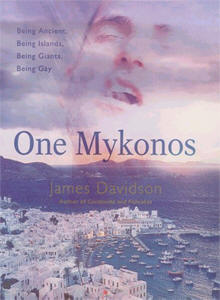 |

 |
|
One Mykonos: Being Ancient, Being Islands, Being Islands, Being Gay by James Davidson; St. Martin's Press, 152 pages, $19.95.  The Greek island of Mykonos is one of the world's most popular gay resorts. According to the
Spartacus International Gay Guide, "After a period of relative inactivity,
the island of Mykonos has once again become a paradise for gay tourists from
around the world. For this reason a generally young crowd is to be found
here, enjoying lots of parties and action."
The Greek island of Mykonos is one of the world's most popular gay resorts. According to the
Spartacus International Gay Guide, "After a period of relative inactivity,
the island of Mykonos has once again become a paradise for gay tourists from
around the world. For this reason a generally young crowd is to be found
here, enjoying lots of parties and action."
"Modern Mykonos, writes author James Davidson, who's "been there twice", "is a holiday resort in the Aegean, an island famous for its nightlife, a honeypot in summer where holidaymakers and homosexuals buzz tolerantly side by side, a place where a certain section of the international play-set choose to moor their yachts from May to September." Mykonos, adds Davidson, is "your idea of what a Greek island should look like", full of white-washed old buildings, windmills, beaches and, no doubt, hot, swarthy, young Greek men. But not even Davidson could give Mykonos what it never had, which is a past: "history is largely absent from Mykonos". Eric Chaline, in Gay Planet, agrees, noting that Mykonos does "not have the historical cachet of the Greek islands of Santorini, Rhodes, or Crete", not to mention Lesbos.
Thus, in writing One Mykonos, Davidson combined a historian's perspective with the modern-day sensibilities of a contemporary gay man. Unfortunately for One Mykonos, its author put too much of the historian and too little of the gay man into the making of his book. This is a problem because, in Mykonos, the gay activity outweighs the history. If there is not much history in Mykonos, what is there to occupy the historian? As it turns out, Mykonos is right next door to Delos, which is chock-full of history. As a result of this happy coincidence, much of One Mykonos is devoted to "one Delos", from its role as the birthplace of Apollo and Artemis to the days when it served as treasurer of the Athenian-controlled Delian League. (It also gave its name to countless persons of both genders, including this critic's mother.) In fact, there is so much history in Delos that a writer would be forgiven for ignoring Mykonos --if his book wasn't about Mykonos. Travel books generally fall into one of three categories. They are either a guide, a study or an excuse for the author to write about whatever he wants. One Mykonos is partly a study of the island but mostly an excuse for Davidson to write a 152-page stream of consciousness which does not help the reader who wants to learn something about Mykonos. In fact, the reader will have to wade through pages of digressions before he gets to the island of Mykonos, much less to the act of "being ancient, being islands, being giants, being gay" as the book's silly subtitle puts it. Only after the book is halfway through does the reader finally get to Mykonos and to James Davidson, who's no doubt busy "being gay". However, no sooner do we meet Davidson and his friends "Muppet" and "Tuppet" at the gay nude beach than the narrative takes us back again to classic times, when I suppose Davidson's scholarship stands on firmer ground. Davidson takes time out from his historical rambles to analyze some of the other foreigners on the island, "representative[s] from every part of the gay diaspora": Italians, Spaniards, Dutch and Germans who "have moustaches and look like dying Gauls" (the statute), and even "modern Greeks from Athens huddling together in a corner of their own." There are even Americans, whose "gym-built bodies and loud voices seem to take up much more space than a similar number of Europeans" and whose muscles scare the author into putting on his shirt. "Although the confidence of Americans seems so alien, their passion for executions, their love of guns, you have to acknowledge that ninety per cent of gay liberation is thanks to them also. America is a battlefield of competing identities," adds Davidson. This is true, but what does it have to do with Mykonos?! Though I've never been to Mykonos, I heard it is a nice place to visit, for gays and straights alike. A good book about Mykonos, written from a gay perspective, would make a delightful read. Unfortunately, One Mykonos is not that book. And while he is an excellent student of ancient times, Davidson's take on the present leaves much to be desired. |
 © 1997-2002 BEI
© 1997-2002 BEI